Liquid Lipsticks & Sealers
In 1938, Princess Pat introduced a new liquid lip make-up called Liquid Liptone. It was advertised as a liquid lipstick even though the idea of a liquid lipSTICK does not really make sense. As far as I can tell, they were the first cosmetic company to use the term.
See also: Princess Pat.
Liquid Liptone
Earlier liquid lip make-up was made by dissolving dyes in a suitable solvent with a little glycerine usually included to reduce lip drying. The resulting make-up stained the lips rather than covering it with colour and these products were generally sold as a lip stains, lip tints, or liquid lip rouges.
Liquid Liptone differed from these earlier forms because it covered the lips with a coloured, water-resistant film. The film was made using ethyl cellulose dissolved in ethyl alcohol combined with a suitable plasticiser, such as castor oil, to reduce the possibility of the film flaking from the lips and to slow down the evaporation rate of the alcohol (Poucher, 1974). Different shades were produced using bromo acid (fluorescein) dyes, previously employed in other make-up such as indelible lipsticks.
Liquid Liptone: “The sensational new liquid lipstick that really and truly can’t smear! . . . and can’t come off! Here, at last, is color so utterly loyal it hugs your lips in absolute defiance of anything that might tempt it to desert. It also preserves the natural moisture of the lips.” Shades: English Tint, Light, Topic, Parisian, Medium, and Regal.
See also: Indelible Lipsticks
The formula for Liquid Liptone was developed by Milton Klimist [1902-1975] and was covered by a patent (US Patent, No. 2,230,063). Klimist provided example recipes in the patent application, including the one given below:
Example III (Percent) Ethyl cellulose 3.5 Ethyl alcohol 90.7 Castor oil 5.0 Tetra-bromo eosin 0.8 (Klimist, 1941)
Liquid Liptone’s novel formulation generated some interest from cosmetic chemists. They picked up the term liquid lipstick coined for Liquid Liptone and used it to describe any liquid lip make-up of a similar type. A number of recipes for liquid lipsticks then began appearing. For example, deNavarre (1941), writing after Liquid Liptone was introduced, provided a recipe for a liquid lipstick adding tincture of benzoin to increase adhesiveness and to help overcome the drying effect of the cellulose film.
No. 219 Parts Ethyl Cellulose 2 Plasticiser 1 Tr. Benzoin 1 Solvent 96 Dyestuff and Perfume qs Procedure: Dissolve the dye in one half of the solvent and filter the solution. Now add the ethyl cellulose in small portions and allow to stand with intermittent shaking until solution is complete. Perfume, then add the plasticizer to other half of solvent and stir in, filter bright and mix with ethyl cellulose solution.
(deNavarre, 1941, p. 388)
Poucher (1974) includes a similar formula but included lake colours as well as the bromo dyes.
No. 2228 Ethyl cellulose (80-105 cps) 90 Ethyl alcohol 768 Bromo acids 2 Castor oil 105 Lake colours 35 1000 (Poucher, 1974, p. 220)
As well as ethyl cellulose other polymers were used to create the film including cellulose acetate, nitrocellulose, polyvinyl alcohol and polyvinyl acetate (Keither, p. 163).
Liquid Liptone was not without its problems. As the alcohol evaporated it could sting the lips and the product required an alcohol-based remover to take it off. It also suffered from the portability issues of previous liquid lip make-up. They could spill in the purse or splash colour on clothes when being applied.

Above: 1945 Liquid Liptone and remover.
Interest in this type of liquid lipstick declined in the 1950s when new indelible lipsticks arrived on the market. These promised similar benefits, such as being ‘kissproof’ and ‘smearproof’, and eventually liquid lipsticks like Liquid Liptone disappeared.
See also: American Lipstick Wars
There are products that describe themselves as liquid lipsticks on the market today but they bear no resemblance to the liquid lipsticks of earlier times. These modern liquid lipsticks, which began to appear in the late 1990s, are more like stick lipsticks in formulation so are perhaps better deserving of the term. However, although the older type of liquid lipstick is no longer around, products that covered the lips with a film continued to be produced in the form of lipstick sealers.
Lipstick sealers
One of the fortunate characteristics of ethyl cellulose is that it is compatible with the ingredients found in stick lipsticks. When used over a lipstick it makes it more indelible as well as giving it added gloss (deNavarre, 1975, p. 829). Gordon & Gordon, the owners of Princess Pat, came to realised this and started recommending applying Liquid Liptone over cream lipsticks to seal them. They followed this idea up by adding a Clear version of Liquid Liptone in 1948.
You can use it to prevent cream lipstick from smearing, too. Just brush on a coat of Liptone after lipstick.
(Liquid Liptone advertisment, 1948)
Effectively, these lipstick sealers were liquid lipsticks of the ethyl cellulose type made without colourants. Poucher (1974) includes a stripped down formulation but I doubt if any liquid sealers were made as basic as this.
No. 2229 Ethyl cellulose (8-11 cps) 100 Ethyl alcohol 900 1000 (Poucher, 1974, p. 221)
One of the earliest lipstick sealers was Lip-Cote. Introduced into Britain by British Glandular Products in 1949, it is still on the market today.
Lip-Cote: [T]he long-needed cosmetic for perfecting lip beauty. Just brush this magic clear liquid over your favourite lipstick and it instantly banishes embarrassing lipstick smears from kisses . . . unsightly stains on anything your lips might touch. One bottle lasts months. You use less lipstick too.”
Lip-Stae from Renoir Parfums came a little earlier. It debuted in the United States in 1947, the year before Liquid Liptone added its Clear shade. Lip-Stae subsequently underwent a name change becoming Nu-Lips in 1949.
Nu-Lips: No more stains on line . . . no more smears on glasses . . . no more tell-tale kisses, when clear liquid Nu-Lips is brushed over your lipstick.”
Other lip sealers followed but they were never very popular as most women did not feel the need to use them. They are still available today and an examination of their ingredient lists shows that they owe a debt to Klimist’s long expired patent.
Lip-Cote. Ingredients: Alcohol denat., Butyl stearate, Ethylcellulose, Isopropyl alcohol, Shellac, Colophonium, Styrax benzoin gum, Aqua (water), parfum (fragrance), Benzyl alcohol, Benzyl benzoate, Benzyl salicylate, Cinnamyl alcohol, Cinnamal, Hexyl cinnamal, and Hydroxycitronellal.
Mehron LipStix. Ingredients: SD Alcohol 38B (Alcohol Denat.), Glycerin, Acrylates/Octylacrylamide Copolymer, Ethylcellulose, and Hydroypropylcellulose. May Contain: [+/- CI 17200 (Red 33)].
Art Deco Magic Fix. Ingredients: Alcohol Denat., Aqua (water), Ethylcellulose, Ricinus communis (castor) seed oil, Lavandula augustiflora (lavender) oil, Citrus aurantium bergamia (bergamot) oil, Fruit oil, Linalool, and Limonene.
First Posted: 17th April 2024
Sources
deNavarre, M. G. (1941). The chemistry and manufacture of cosmetics. Boston, MA: D. Van Nostrand Company, Inc.
deNavarre, M. G. (1975). Lipstick. In M. G. deNavarre (ed.) The chemistry and manufacture of cosmetics (2nd ed., Vol. IV, pp. 767-840). Orlando: Continental Press.
Keithler, W. M. R. (1956). The formulation of cosmetics and cosmetic specialties. New York: Drug and Cosmetic Industry.
Klimist, M. (1941). Liquid lip rouge preparation. (U.S. Patent, No. 2,230,063). U. S. Patent and Trademark Office.
Poucher, W. A. (1974). Perfumes, cosmetics and soaps (8th ed., Vol 3). London: Chapman & Hall Ltd.
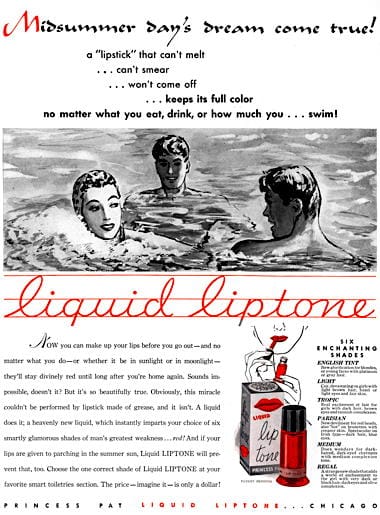
1938 Liquid Liptone. The product was waterproof so proved useful when swimming,
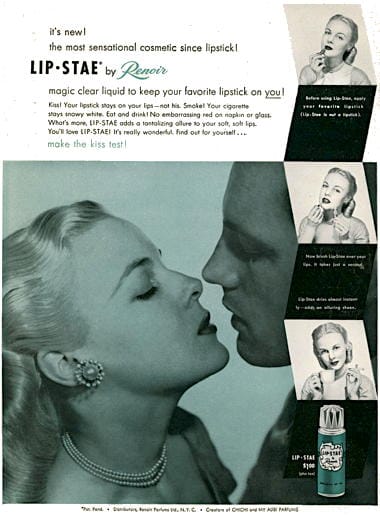
1947 Lip-Stae.

1948 Liquid Liptone.
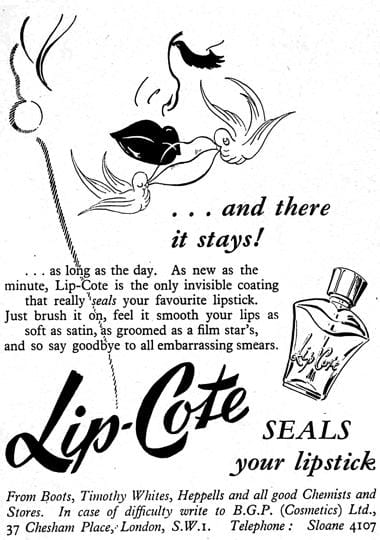
1950 Lip-Cote (Britain).
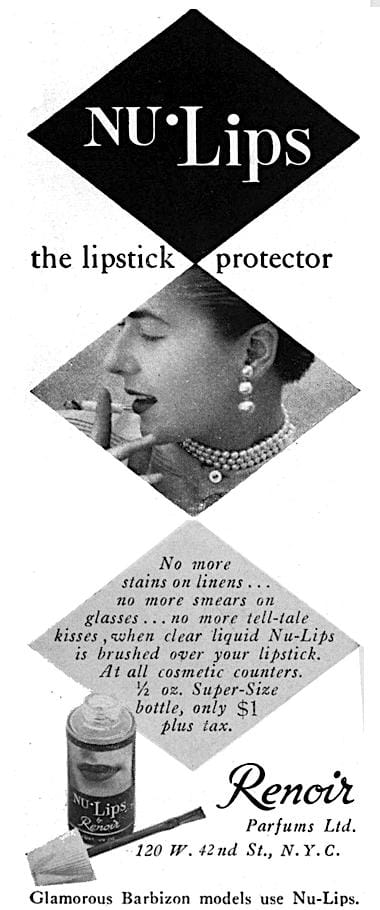
1951 Nu-Lips.
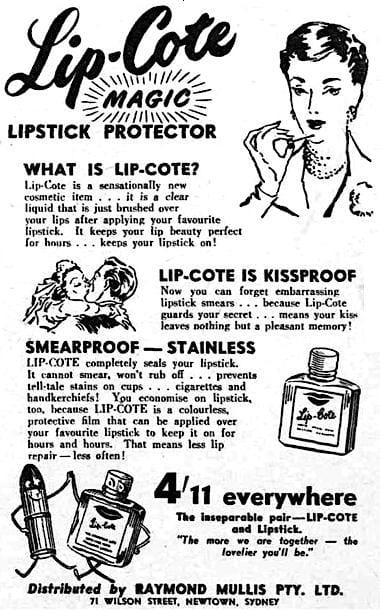
1951 Lip-Cote (Australia).

1955 Lip-Glo liquid lipstick (Australia).
